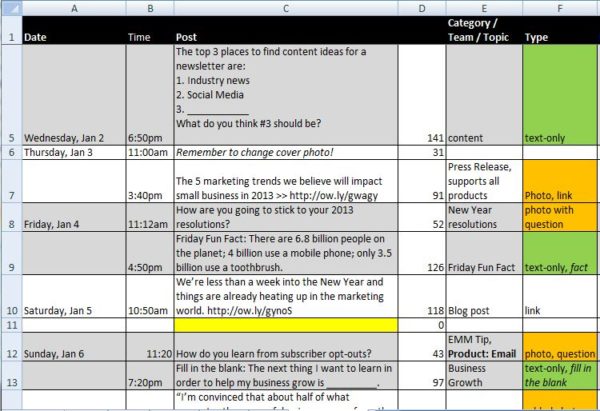The press release has been a mainstay of public relations since its inception decades ago.
And while it may seem a bit old-school to some, there’s a reason press releases have stood the test of time — they’re effective and produce results.
From generating media coverage to positioning yourself as a thought leaders in your industry, and ultimately help your business succeed and grow — there are a number of reasons why business owners need to learn how to write and distribute a press release.
Today, I’ll focus on part one of that process: how to write a press release.
If you’re trying to decide whether or not something warrants a press release, all you need to do is answer one question: Is it newsworthy?
For something to be newsworthy, it must be something that audiences outside of your internal organization will care about; something that has significance to a reporter and their readers, viewers, or listeners, or to other external stakeholders (potential investors, etc).
Here are a few factors to consider when determining if something is newsworthy:
- Impact: Who will this information affect? The broader and larger the impact, the more people will be interested.
- Timeliness: Why does this information matter now? Does your news relate to or tie back to a significant “moment in time” or event of some sort?
- Proximity: As a small business, this one should be easy to understand — proximity matters. For many small businesses or nonprofits, your news will likely matter more to local publications than to national ones, or publications that focus on other regions.
- Name recognition: Clout that comes with big recognizable names (well know people, organizations, companies, etc) will likely increase the interest in your news. If you’re partnering with, or involved with a big name that might generate this type of attention, consider issuing a press release.
Now that you know when to write a press release, let’s take a look at how you actually do it.
Here, I’ve outline the four major components of an effective press release:
1. The headline/subhead
The headline should be attention grabbing and encourage the reader to want to know more, while also being explanatory. This isn’t the time to use vague language.
Formatting tip: Make sure the headline is written in bold and the subhead is italicized.

2. The body
The body of your press release should stay as concise as possible, while making sure to get all of the important information across in an engaging manner. Reporters that read your release aren’t likely going to have the time to read page after page trying to understand the news.
There aren’t really a prescriptive number of pages or word count. It can vary depending upon the information the release is covering. The key is to keep it concise and not overly verbose, but at the same time make sure that you have all the relevant info included. So, the length can really vary depending upon the announcement.
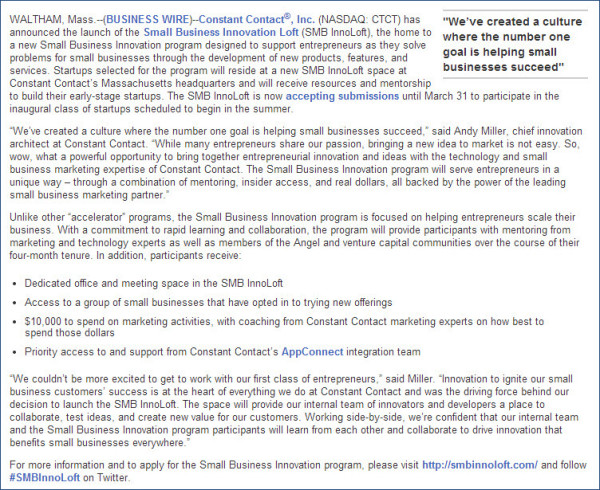
Here are other things to keep in mind when pulling together the body of any press release:
- The dateline: Begin with a dateline of the city in which the press release originated and the date it was issued. This is especially important for small businesses that are distributing their press release to the local media.
- Keep it factual: Your press release should focus on answering the five W’s: who, what, when, where, and why.
- Factual doesn’t have to mean dry: While your press release should be as concise as possible and stick to the facts, it doesn’t have to be as dry as say, a research paper. Keep the language engaging.
- Avoid lazy mistakes: Typos and poor grammar in press releases make your business look unprofessional, and will likely turn off reporters.
- The quote: Most press release include a quote by the most relevant spokesperson for the topic of the release. The quote provides space to add some color commentary (going a bit beyond the factual basis of the rest of the release) and can also be pulled directly from the release by journalists to use in articles.
3. The boilerplate
This is the about us section where you provide background on your organization. It should be included following the body of every press release. The language used here can be the same in every release. Don’t forget to link to your company homepage to drive readers back and provide more information.
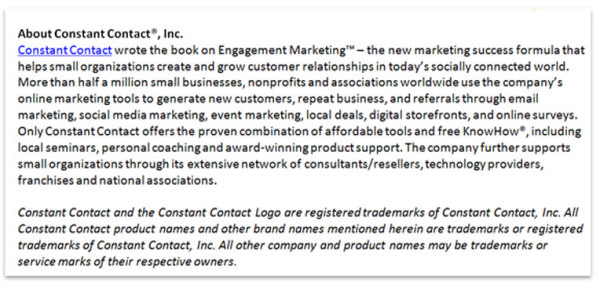
4. Contact Info
A reporter reads your press release and is interested in getting more information — great! But how will they know where to go?
Be sure to include relevant contact info for any inquiries that may arise from your press release.
This information should be listed at the very end of the release.
It doesn’t begin and end with creating the press release.
Keep in mind that while a well crafted press release is the foundation of a great public relations campaign, your efforts should not begin and end with the creation of the release.
Press releases work when you get their information in the right hands (reporters, other stakeholders) that will further extend the reach of your news, ultimately resulting in measurable business success.
Stay tuned for part two, where I’ll explain how to distribute and get results from your press release.
Have other questions about writing a press release? Post them in the comments below.

Melinda F. Emerson, known as “SmallBizLady,” is one of America’s leading small business experts.
Few people are as passionate about small business success as Melinda Emerson, aka SmallBizLady.
Melinda is the founder of The Quintessence Group and consults with Fortune 500 companies and small businesses on social media strategy and content development. She authored the book “Become your Own Boss in 12 Months” and writes for the New York Times You’re the Boss blog.
“I have my dream job. I wake up without an alarm clock because I wake up with a purpose – to end small business failure,” says Melinda. “Like so many small business owners, I figured out my calling and I’m good at it. The challenges of being your own boss are great but the rewards are, too.”
On the occasion of the 15th anniversary of her business, I chatted with Melinda to get her insights into what small businesses can do to thrive. She shared five main reasons why small businesses fail, along with tips for avoiding these common pitfalls:
1. Give up delusions of grandeur
“A lot of people don’t think about all that’s involved in being their own boss,” says Melinda.
While the rewards can be tremendous, she sees people who are under the illusion that they’ll have fewer problems and more time, when the opposite is quite often the reality.
Be prepared to work hard, troubleshoot lots of problems, and learn the art perseverance.
2. Nurture your network
Many people simply don’t have a network to sell to when they start out and that can be hard.
“When people start a business, they need to network,” she says.
According to Melinda, that means returning every phone call, tapping into your network of friends and family, attending industry events, and getting involved in your community.
“Your network is your net worth,” says Melinda.
3. Keep in touch with your customers
“I know plenty of businesses that will let people walk into their shop or restaurant, spend $50 or so dollars, and leave. They don’t make the effort to keep in touch with their customers!”
Melinda advises asking your customers for their contact information so you can send them a thank you note, keep in touch through newsletters, and keep them posted on any special events or offers you have coming up.
“Small businesses owners always ask about how to get new customers but I always ask them, ‘what are you doing with your existing customers?’ Nurture your existing customer base — it’s cheaper to keep a customer than it is to gain a new one.”
4. Pick a niche
Melinda stresses the importance of putting a stake in the ground and finding your area of specialization.
“The recession killed generalists,” says Melinda. “People are seeking someone who specializes in solving their particular problem every day.”
It’s also important to specialize because, as a small business owner, you have limited time and resources so you need to pick a target you can hit.
“You need a niche to get rich. To put it in basic terms, who makes more money, the heart surgeon or the general practitioner?”
5. Know your numbers
People let their fear of math prevent them from knowing what’s going on in the business but fiscal discipline is paramount to success, says Melinda.
“If you don’t manage your household with a budget you won’t manage your business with one. You need to know how much profit is in every sale and how much budget you have to operate your business.”
Keeping your records up-to-date is important because by the 15th of the month you need to know how your business did last month and adjust accordingly. Melinda also points out that marketing is the lifeblood of a business so it’s important to have a monthly marketing budget.
“Don’t just market with what’s left at the end of the month.”
Lastly, she says by knowing your financials you’ll know if you should outsource marketing activities or keep them in-house.
“If your time is worth $200 per hour, you shouldn’t spend it doing $20 per hour work, you should focus on generating more clients that will pay you $200 an hour. Outsource the things that you are not good at or are not a good use of your time,” says Melinda.
We’d love to hear from you: What one lesson did you learn when starting your business that you can share with other small business owners?
Many people know that YouTube can be beneficial for their business, but often fear the time it takes to create something that will resonate with their audience.
There are many ways that you can utilize YouTube for your business, and they don’t always have to involve you or your employees creating a brand new video.
In fact, one of the most effective ways to use YouTube is to curate content instead.
What is curated content?
The concept of curating content, thanks to the internet, is used in most marketing communications. You’ll find curated content everywhere from social media, blogs, email newsletters, and websites.
Curating content allows you to hand-select multi-media content — articles, photos, videos — you enjoy and share it with your audience.
In addition to sharing relevant videos on social media or in your email newsletter, one of the most effective ways to share YouTube videos is to embed them on your website or blog.
This allows you to drive people to your own website, even though you’re sharing someone else’s content. This is where you’ll also be able to add your point-of-view, share your expertise on the subject of the video, and add your own call-to-action to the body of your post or website.
And video is a great way to support the points you’re trying to make.
Studies have shown that 90 percent of information transmitted to the brain is visual, and visuals are processed 60,000 times faster in the brain than text! Adding a video to your website or blog offers a quick and convenient way to get your message (or someone else’s message that fits your needs) in front of your target audience.
Luckily, with 300 hours of video uploaded to YouTube every minute, there are plenty of videos already created that your audience will love.
Find the businesses and professionals whose work you admire, and that you think has something to offer your target audience, and start sharing their content!
For example, Constant Contact creates all kinds of educational videos to help you market your business. For a marketing consultant, these are the types of videos you’d want to share because they are relevant to the work you do and the needs of potential clients.
For other industries, like restaurants, retail stores, or nonprofits — the videos you share will be different.
Now the big question: How do I share a YouTube video on my website or blog?
YouTube lets you grab an embed code and customize the size of your video. This allows you to decide how big you would like the video to be displayed on your website or blog.
Once you find your video of choice, you can retrieve the embed code directly underneath the YouTube video. There you will find a Share tab. Once you click on Share you will select Embed. Under the Embed tab you will find your embed code that you’ll copy on your website or blog.
Take a look:
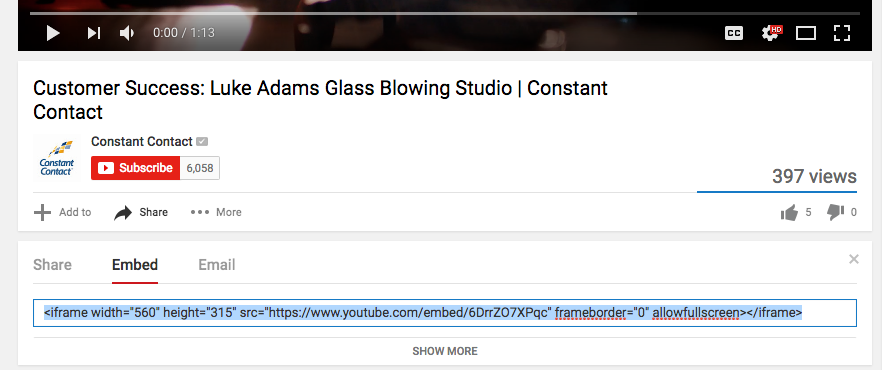
If you have a developer who does this for you, simply send them the code … they’ll know what to do!
If you’re the one in charge of your website and/or blog, copy this code into any platform that allows you to paste HTML and supports embedding. Just remember, you’ll want to paste this code into the source code.
Tip: If your blog is housed using WordPress, just copy the URL found under the Share tab and paste it where you want the video to show up in the post or page. WordPress will automatically embed the video.
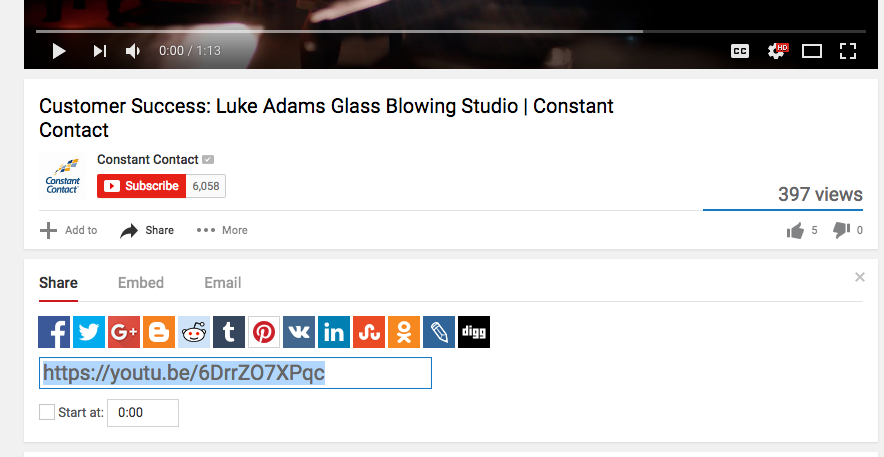
Get started!
Spend some time looking for videos you think your customers would enjoy. If they’re relevant to your business and have something to offer, don’t be afraid to share. Remember to always give credit, so that you can build new relationships with the people and companies creating the content.
If your goal is to educate clients about online marketing, we have a ton of videos on the Constant Contact YouTube Page you can share right away!
Do you use YouTube for your business? Let us know how in the comments below.
Last month we wrote about the value of having a social media posting schedule, and talked about the steps you could follow to put a schedule together.
We received a ton of great feedback from the post!
One of the questions that really stood out was, “How can a busy business owner actually stick to this schedule?”
Having a schedule is one thing; following through with it is something completely different.
As Constant Contact’s social media community manager, I have found that sticking to a consistent posting schedule has been the key to successfully growing our social media presence. It helped us reach our most recent Facebook milestone, 100,000 fans!
To help you stick to your posting schedule, I thought I would share a few tips I’ve learned along the way:
1. Choose a theme
Each month, we decide on an overall theme for our content and brainstorm ideas for blog posts, guides, newsletters, and social media content that reflects the chosen theme.
Ideas that stem from these brainstorms help fill out my Facebook posting schedule for that month.
A theme will help you stay focused, but will also help simplify your content creation process. This means less time staring at a blank status box, wondering what you’re going to share each week.
2. Create a template
In our previous post, we included a few cheat sheets to help you create your social media schedule. But also make sure you have a template you are comfortable using when creating a schedule on your own.
To keep track of each month’s schedule, I use Excel — nothing fancy.
In the first column, I list out every day of the month, fill in the upcoming Constant Contact events, holidays, and anything else I want to remember.
My next columns are the time of day to post, content, character count (Excel formula =LEN(C1) ), topic, and content type. I highlight the content column in yellow to draw attention to days where I don’t have a piece of content yet.
Here’s a peek at how it looks:
3. Use a calendar to fill your schedule
All of the content you share doesn’t have to map to your monthly theme. One of the ways I mix things up, is by factoring in things like holidays and current events. I’ll even look at random holidays like National Compliment Day.
Having these days built in our schedule, takes a lot of the stress out of planning each month.
By focusing on days and current events that are relevant to your brand, and of interest to your audience, you can create fun and engaging content and improve your chances of sticking to your schedule each month.
You can also come up with re-occurring post ideas, based on the days on the week. We post motivation quotes on Motivational Monday and on Fridays we share interesting statistics for Fun Fact Friday.
4. Find your sources of inspiration
Inspiration can come from a lot of places. For us, it starts with our audience.
By listening to our fans and followers, engaging with them on a regular basis, and paying attention to our social media insights — we’re able to learn what our audience is most interested in.
There’s a good chance that you have ‘real life’ relationships with your Facebook fans, and they share the passion you have for your business too. You can tap into these people for inspiration anytime you need it.
I also get a lot of inspiration from other brands. It’s great to see what other people in our industry are doing, as well as other brands who may not be speaking to the same audience as us.
Find the businesses that inspire you. If you have a relationship with the business owner, don’t be afraid to reach out to see how social media has worked for them.
5. Capture your ideas
It’s important that when you do have ideas for great social media content, you can capture them right away. There’s nothing worse than thinking about something you know your fans and followers will love, and then forgetting about it when it comes time to post.
I keep an ongoing document in Microsoft Word called, Future Facebook Post Ideas. Once again, there’s nothing fancy about it. It’s just a running list of ideas that I can rely on every time I’m struggling to come up with posts.
Anyone could do this in a notebook or with an app like Evernote on their phone.
Stick with it!
Here at Constant Contact, we are lucky to have a team of people dedicated to maintaining and growing our social media presence. But even without a full team, you can use tips like these to help you stay active and focused on your social media goals.
As you get started, pay attention to the things that work for you. Everyone will have their own tricks for sticking to their schedule, the secret is finding a strategy that works for you!
Do you have other tips for sticking to a social media schedule? Post them in the comments below.

